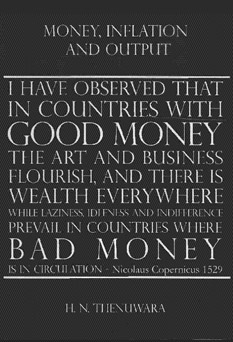The thesis of Thenuwara’s book is ‘good money’ creates wealth and growth while ‘bad money’ would retard this—an observation made by Copernicus in 1529 A.D. The underlying theme of the book is the need for a Central Bank to conduct an independent monetary policy and thereby keep inflation low, which is essential to achieve higher economic growth. Some of the chapters explain basic economic concepts in the context of monetary policy while others show how monetary policy has worked and the prerequisites for positive results. When money circulation is not matched by an increase in the supply of goods, prices increase and create inflation. Inflation inertia is created when past high inflation makes it difficult to control current and future inflation. When the public is used to a high rate of inflation, they incorporate high inflation rates into future economic plans—expectation causes the inflation to persist by way of a self-fulfilling phenomenon. Thus to combat adverse expectations on inflation, Central Banks make an effort to sensitize the public on their plans to reduce inflation and provide forecasts of future inflation levels.
Several instruments can be used to conduct monetary policy: interest rates, the statutory reserves, moral suasion, central bank communications, and administrative instruments to control aggregate demand. The book shows that the most effective and convenient instrument is the interest rate for conduct of monetary policy. But the market players should be sensitive to this. If the government is a major borrower in the market, and does not change its demand for credit when changes occur in the interest rates, then monetary policy becomes ineffective. The need for proper coordination between monetary authorities and fiscal policy officials to obtain best results from monetary policy is highlighted.

